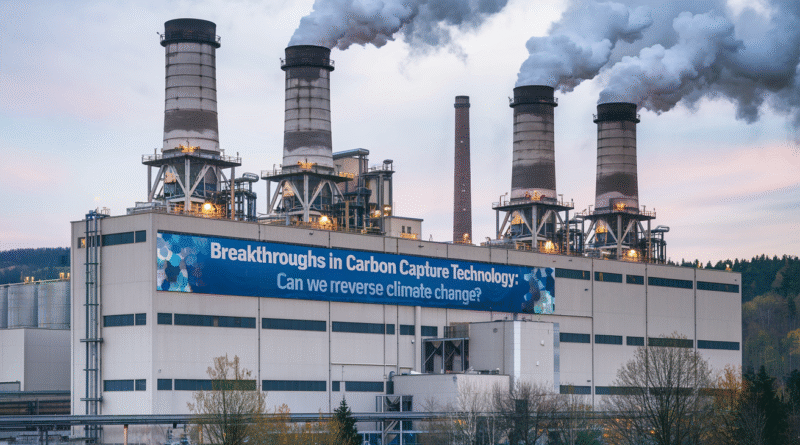Breakthroughs in Carbon Capture Technology: Can We Reverse Climate Change?
As climate change continues to wreak havoc on the environment, scientists and innovators are increasingly turning to advanced technologies to address the rising levels of atmospheric carbon dioxide (CO2). Among these technologies, carbon capture has emerged as a promising solution to curb global warming. This process involves capturing CO2 emissions from industrial sources and either storing them underground or repurposing them. With recent advancements in carbon capture, many are asking whether this technology could be the key to reversing the impacts of climate change.
The Critical Need for Carbon Capture
The global rise in temperatures is being driven by the excessive accumulation of greenhouse gases, primarily CO2, in the atmosphere. Human activities such as fossil fuel consumption, industrial operations, and deforestation have significantly contributed to the release of carbon emissions, which trap heat and result in extreme weather events, melting ice caps, and rising sea levels.
While transitioning to renewable energy is crucial for reducing future emissions, experts agree that simply cutting emissions is no longer enough. To limit global warming to 1.5°C, as outlined in the Paris Agreement, we must also remove existing CO2 from the atmosphere. This is where carbon capture and storage (CCS) technology comes into play.
How Carbon Capture Works
Carbon capture technology focuses on trapping CO2 emissions before they are released into the atmosphere. Once captured, the CO2 is either stored underground in geological formations or used in various industries. The process generally includes three key stages:
- Capture: CO2 is separated from other gases produced during industrial processes like power generation or cement manufacturing. Techniques used include absorption, adsorption, and membrane separation.
- Transportation: Captured CO2 is compressed into a supercritical fluid and transported via pipelines, ships, or trucks to storage or utilization sites.
- Storage or Utilization: Captured CO2 can either be sequestered deep underground in saline formations or depleted oil and gas fields. Alternatively, it can be used in industrial applications, such as producing concrete or synthetic fuels.
Pioneering Advances in Carbon Capture Technology
Direct Air Capture (DAC)
Direct Air Capture (DAC) technology is a groundbreaking innovation that removes CO2 directly from the atmosphere. Companies like Climeworks (Switzerland) and Carbon Engineering (Canada) are at the forefront of DAC, employing systems that use large fans to draw in air and separate CO2. The captured CO2 is then stored or repurposed for commercial products, such as synthetic fuels.
Although DAC is still in its early stages and faces cost and scalability issues, it holds great potential, particularly for sectors that are difficult to decarbonize, such as aviation and heavy industry.
Carbon Utilization
Instead of merely storing captured carbon, researchers are exploring ways to use CO2 effectively. One notable development is the integration of CO2 into concrete production. Companies like CarbonCure are injecting captured CO2 into concrete during its mixing process, not only trapping the carbon but also strengthening the concrete. This innovation offers a dual benefit: reducing emissions from the construction industry while repurposing captured CO2.
Overcoming Challenges in Carbon Capture
Despite its promise, carbon capture technology faces several significant obstacles:
High Costs
One of the major hurdles for widespread adoption is cost. Traditional carbon capture methods can range from $50 to $100 per ton of CO2 captured, while DAC costs can soar to $600–$1,000 per ton. Reducing these costs will be critical for the broader deployment of the technology. Efforts to improve materials and optimize processes are underway, alongside financial incentives like carbon credits, which may help make the technology more affordable.
Scaling Up
For carbon capture to have a meaningful impact on climate change, it must be deployed on a large scale. Currently, global carbon capture capacity is only around 40 million tons annually, a small fraction of the approximately 36 billion tons of CO2 emitted worldwide in 2022. Expanding the infrastructure for capturing, transporting, and storing CO2 will require substantial investments and policy support.
Public Perception and Political Support
Public opinion on carbon capture is divided. Some critics argue that it could allow industries to continue emitting CO2 rather than tackling the root causes of climate change. There are also concerns about the risks associated with underground carbon storage, such as potential leakage. Government policies, such as carbon taxes, cap-and-trade systems, and subsidies, will be essential in promoting the adoption of carbon capture technologies.
The Role of Carbon Capture in Combating Climate Change
Despite the challenges, carbon capture remains one of the most promising solutions for mitigating and potentially reversing the effects of climate change. According to the Intergovernmental Panel on Climate Change (IPCC), achieving net-zero emissions by 2050 will require widespread implementation of carbon capture technology, alongside deep cuts in fossil fuel use and the transition to renewable energy.
In addition to reducing industrial emissions, carbon capture can also remove CO2 already in the atmosphere, a concept known as « negative emissions. » This will be crucial for sectors such as agriculture and aviation, where emissions are harder to eliminate. Technologies like DAC, along with natural solutions like reforestation and soil carbon sequestration, will be vital components of a comprehensive climate strategy.
The Future of Carbon Capture
The future of carbon capture technology is both promising and uncertain. Although current costs are high and deployment remains limited, ongoing innovations and increased investments could bring us closer to large-scale adoption. The key to success will be lowering costs, building necessary infrastructure, and ensuring that carbon capture is part of a broader climate action plan that also includes emissions reductions, renewable energy expansion, and nature-based solutions.
As these technologies mature, they could become essential tools in mitigating the damage caused by decades of industrial emissions, offering hope that we can reduce the worst impacts of climate change. The challenge lies in making these technologies scalable, affordable, and accessible to help humanity tackle one of its greatest threats—global warming.

